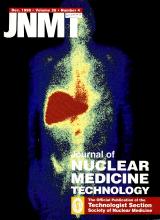Abstract
Objective: Right-angle dual-headed tomography has increased cardiac SPECT utility by cutting acquisition time in half which enhances gating capabilities. When gating, however, a deceleration in heart rate, due to a return to baseline rate after stress or lessened anxiety at the end of a study, may significantly affect the last step(s) of a gated study with possible frame or information loss. The purpose of this study was to illustrate the artifacts produced in myocardial perfusion studies when a frame or frames are lost in single- and dual-detector SPECT imaging methodologies.
Methods: A near-normal 99mTc-sestamibi study was obtained using a dual-headed camera system fitted with high-resolution, long-bore collimators. The normal study was processed including all frames (1–32). To demonstrate the effect of losing frames on a dual-headed system, the study was processed three different ways to simulate frame loss.
Results: Loss of frames at the end of a SPECT acquisition results in significant inferoseptal wall defects, left ventricular lumen narrowing, as well as thinning of the anterior and lateral walls. The overall appearance of the heart is a more oval-shaped heart with decreased perfusion. The effect of losing the last frame in a dual-headed camera system as opposed to losing the last frame in a single-headed camera system is more substantial.
Conclusion: A scan resulting in the loss of a frame in either a single- or a dual-headed camera system creates artifacts in the myocardial wall and should always be repeated. It is significant to note that artifacts present in a dual-headed system are much more prevalent than in a single-headed system due to the nature of dual-headed acquisition parameters.







